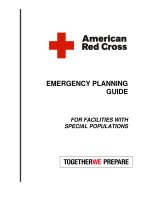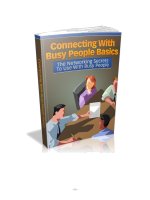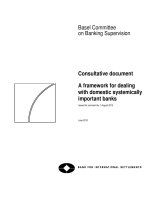Perfect Phrases for Dealing with Difficult People
Bạn đang xem bản rút gọn của tài liệu. Xem và tải ngay bản đầy đủ của tài liệu tại đây (870.86 KB, 242 trang )
Perfect Phrases for Dealing
with Difficult People
This page intentionally left blank
Perfect Phrases for Dealing
with Difficult People
Hundreds of Ready-to-Use Phrases for
Handling Conflict,Confrontations,and
Challenging Personalities
Susan F. Benjamin
McGraw-Hill
New York Chicago San Francisco Lisbon
London Madrid Mexico City Milan New Delhi
San Juan Seoul Singapore Sydney Toronto
Copyright © 2008 by Susan F. Benjamin. All rights reserved. Manufactured in the United
States of America. Except as permitted under the United States Copyright Act of 1976, no
part of this publication may be reproduced or distributed in any form or by any means, or
stored in a database or retrieval system, without the prior written permission of the
publisher.
0-07-159512-0
The material in this eBook also appears in the print version of this title: 0-07-149304-2.
All trademarks are trademarks of their respective owners. Rather than put a trademark
symbol after every occurrence of a trademarked name, we use names in an
editorial fashion only, and to the benefit of the trademark owner, with no intention of
infringement of the trademark. Where such designations appear in this book, they have
been printed with initial caps.
McGraw-Hill eBooks are available at special quantity discounts to use as premiums and
sales promotions, or for use in corporate training programs. For more information, please
contact George Hoare, Special Sales, at or (212)
904-4069.
TERMS OF USE
This is a copyrighted work and The McGraw-Hill Companies, Inc. (“McGraw-Hill”) and
its licensors reserve all rights in and to the work. Use of this work is subject to these terms.
Except as permitted under the Copyright Act of 1976 and the right to store and retrieve one
copy of the work, you may not decompile, disassemble, reverse engineer, reproduce, mod-
ify, create derivative works based upon, transmit, distribute, disseminate, sell, publish or
sublicense the work or any part of it without McGraw-Hill’s prior consent. You may use
the work for your own noncommercial and personal use; any other use of the work is
strictly prohibited. Your right to use the work may be terminated if you fail to comply with
these terms.
THE WORK IS PROVIDED “AS IS.” McGRAW-HILL AND ITS LICENSORS MAKE
NO GUARANTEES OR WARRANTIES AS TO THE ACCURACY, ADEQUACY OR
COMPLETENESS OF OR RESULTS TO BE OBTAINED FROM USING THE WORK,
INCLUDING ANY INFORMATION THAT CAN BE ACCESSED THROUGH THE
WORK VIA HYPERLINK OR OTHERWISE, AND EXPRESSLY DISCLAIM ANY
WARRANTY, EXPRESS OR IMPLIED, INCLUDING BUT NOT LIMITED TO
IMPLIED WARRANTIES OF MERCHANTABILITY OR FITNESS FOR A
PARTICULAR PURPOSE. McGraw-Hill and its licensors do not warrant or guarantee
that the functions contained in the work will meet your requirements or that its operation
will be uninterrupted or error free. Neither McGraw-Hill nor its licensors shall be liable to
you or anyone else for any inaccuracy, error or omission, regardless of cause, in the work
or for any damages resulting therefrom. McGraw-Hill has no responsibility for the content
of any information accessed through the work. Under no circumstances shall McGraw-Hill
and/or its licensors be liable for any indirect, incidental, special, punitive, consequential or
similar damages that result from the use of or inability to use the work, even if any of them
has been advised of the possibility of such damages. This limitation of liability shall apply
to any claim or cause whatsoever whether such claim or cause arises in contract, tort or
otherwise.
DOI: 10.1036/0071493042
We hope you enjoy this
McGraw-Hill eBook! If
you’d like more information about this book,
its author, or related books and websites,
please click here.
Professional
Want to learn more?
To Mary Roadruck, whose outrageous humor and goodwill are
the perfect anecdotes for difficult people everywhere.
This page intentionally left blank
Contents
Acknowledgments xi
Part One: What You Need to Know
Why Address Difficult People 3
Top Seven Imperatives of Communicating with
Difficult People 4
Part Two: Perfect Phrases for Communicating
with Difficult Coworkers
Unfriendly Coworkers 15
Coworkers Who Withhold 17
Petty and Gossipy Coworkers 21
Argumentative People 26
Loud and Obnoxious Coworkers 32
Negative Coworkers 36
When That Negative, Angry, or Difficult Employee Is You 41
Part Three: Perfect Phrases for
Communicating with Difficult Bosses
Bully Bosses 47
Unfocused and Forgetful Bosses 52
vii
For more information about this title, click here
Distant, Weak, or Hands-Off Bosses 57
How to Ask for an Overdo Promotion or Raise 62
Micromanagers 66
How to Correct Your Boss’s Mistakes 71
How to Get a Letter of Recommendation from a
Reluctant Boss 74
How to Say Good-bye to a Problem Boss—Without
Burning Bridges 78
Part Four: Perfect Phrases for Communicating
with Difficult Employees
Complainers 85
How to Address Inappropriate Behavior, Dress,
or Hygiene 90
Employees Who Spread Rumors 96
Lazy or Lethargic Employees 99
Passive-Aggressive Employees 107
Angry Employees 115
Stuck-in-the-Box Performers 124
How to Settle Disputes Between Employees 131
How to Motivate Employees Who Resist Change 138
Part Five: Perfect Phrases for Communicating
with Difficult Customers
Angry Customers 151
Antsy and Anxious Customers 159
How to Help Customers Adapt to Changes 163
How to Resolve Billing Problems with Customers 169
How to Manage Demanding Customers 177
viii
Contents
Part Six: Perfect Phrases for Communicating
with Difficult Vendors and Employees from
Other Departments
How to Control a Coworker from Another Department in a
Meeting with Customers 187
Difficult Contractors 193
Difficult Vendors and Suppliers 199
How to Negotiate Finances with Difficult Vendors
and Contractors 206
Disruptive Participants in Presentations 210
ix
Contents
This page intentionally left blank
Acknowledgments
I
’d like to start by acknowledging all those not difficult people
who have helped me with this project: most notably my
agent, Grace Freedson, who’s more than easy to talk
to—she’s fun. Thanks also to my editor at McGraw Hill, Donya
Dickerson, and all those other helpful folks I’ve encountered
throughout this project.
Also, thanks to Janice Seimsen and Sandy Rawdon for their
interest in a related project, as well as to those folks who make
sure my books get into the laps of readers: Mary Roadruck,
Michael Dresser, Susan Greenman, and those wonderful
publicity people I’ve met over the years. Of course, big thanks
go to my son, Adam. Trying to teach him how to deal with
difficult people,and not become one himself, has been a pretty
amazing task.
Last, and most important, a big thanks to all those truly
difficult people I have met over the years. You know who you
are, and the lessons you taught me have been indispensable!
xi
Copyright © 2008 by Susan F. Benjamin. Click here for terms of use.
This page intentionally left blank
Part One
What You Need to Know
Copyright © 2008 by Susan F. Benjamin. Click here for terms of use.
This page intentionally left blank
Why Address Difficult People
Managing Your Expectations—and Theirs
Why confront, e-mail, or otherwise communicate with difficult
people at work? People who, say, drive you crazy, cause work
slowdowns, and make life miserable every time they can? Many
people believe the reasons go something like this: “I want to
put my foot down once and for all.” Or “I’ve got to get these
feelings off my chest.” Or “I’m going to tell that guy what he
can do with his attitude.” And sometimes there are other, even
less savory reasons.
But here’s a reality check: The real reason to communicate
with difficult people is to improve your work life and theirs, not
to mention the lives of your boss, coworkers, and, most impor-
tant, customers. Even when those difficult people are the cus-
tomers. As for whether you like those people or they like you,
whether you become bosom buddies or maintain a respectful
distance is inconsequential.
Granted, you will need different strategies for communicat-
ing with different people.The angry customers must be calmed
and controlled while the lethargic employees must be ener-
gized. You can use the following tips in all your work interac-
tions, and they will boost your communication to the most
successful level possible.
With that in mind, read the following seven imperatives and
apply them no matter who is causing you trouble.
3
Copyright © 2008 by Susan F. Benjamin. Click here for terms of use.
Top Seven Imperatives of Communicating
with Difficult People
1. Be Objective
Objective language can be your best friend when communicat-
ing with difficult people, and it is often the only way to get the
response you want.Trust me, it’s helpful outside of work also—
with difficult neighbors, children, and even friends.
So what is objective language? Say a coworker is disrup-
tive. That’s your subjective opinion. Will the coworker agree?
Doubtful. But if you present objective facts and rely on what
you saw and heard, then the true situation becomes clear and
undeniable. Does your coworker talk too much at meetings?
Stop in your office to chat … on an hourly basis … and break
your work flow? With those facts at hand, now your coworker
can identify the problem exactly.
Look at the difference between subjective and objective
language here:
Subjective: You are irritating to other employees who
want to get work done.
Objective: You interrupt people by dropping by their work
space to chat.
Subjective: You’re really annoying in meetings.
Objective: You need to stay in the meetings and talk only
when the facilitator calls on you.
Subjective: You don’t respect other people.
Objective: You routinely call other people derogatory
names.
4
Perfect Phrases for Dealing with Difficult People
Copyright © 2008 by Susan F. Benjamin. Click here for terms of use.
Even better, once the person can understand the problem
objectively, he or she can find the solution. Call other people
names? Well, stop doing it.
2. Use Examples
When discussing a person’s bad behavior at work, the response
you get may be “Huh?” as in “I have no idea what you’re talk-
ing about,” even though you’ve been objective and clear,
and—face it—it’s such an obvious problem everyone knows
what you’re talking about, even the cleaning staff. So use
an example to illustrate what you mean. Let’s get back to an
example from the last section on objective language—”You
need to stay in the meetings and talk only when the facilitator
calls on you.”
Assuming your coworker doesn’t have a bladder problem,
that’s a fair request. Yet your coworker responds with an open
mouth and hurt expression as if to say, “But I do sit in the
meetings. I never miss a word.” Your only recourse is to provide
an example, such as “Yesterday, at the managers’ meeting, you
got up three times.” Then, lest the coworker claim the event
was a mere exception to otherwise great meeting etiquette,
give another example: “And during my presentation last week,
you were in and out at least two times.”
If, rather than your coworker, this person happens to be
your employee, record these examples. Be clear about names,
dates, and other specifics.You may need them later.
3. Commit to the Accuracy Principle
Be accurate.Always.Say, for example,you accused that annoying
coworker of walking out on meetings “about 10 times.”Granted,
5
What You Need to Know
you didn’t literally mean 10 times—you were only trying to
make a point.But,sadly,the point was lost in the exaggeration of
the number. Are you a manager? Then accuracy is a must in your
performance reviews too—especially with difficult employees.
Being accurate can foster trust, motivate employees to change
their behavior,and enhance the goodwill about everything from
potential pay increases to awards.
Regardless of whether you’re dashing off a quick e-mail or
writing a formal written review,use exact,supportable,and, yes,
objective language by addressing these questions:
■ What was the degree of the behavior? How did you
determine that?
■ How often did it occur?
■ What were the direct repercussions? How can you
measure them?
■ Did you or anyone else confront this problem before?
When and how often?
4. Take Advantage of Venues
All forms of messages are not equal.People retain considerably
more of the written word than the spoken word, provided
that they actually read it. Still, in face-to-face discussions, you
can get cues to help you refine or otherwise position your
message, whether a quizzical expression, a smile, or a subtle
shake of the head.
Here are a few pointers that can help.
Written Message
■ The first few words are critical: They’re the ones people
remember and will set a tone for the rest.
6
Perfect Phrases for Dealing with Difficult People
■ Avoid unnecessarily formal language. It can sound unduly
angry, cold, or alienating. Granted, you don’t want to use
syrupy phrases either. But keep the tone neutral or, if you
dare, friendly.
■ Have lots of points? Are you addressing a rebel employee
who refuses to follow procedures? Use bullets, numbers,
or steps.They’re easy to see and impossible not to
follow.
Spoken Message
■ Employees and coworkers hear only every fifth word or so,
and that means you need to repeat key points throughout
the discussion.
■ Watch for body language—yours and your employee’s or
coworker’s. Sit down to talk and see that your employee or
coworker has crossed arms and an indirect gaze? This
could signal hostility. But continue watching his or her
body language throughout the discussion for signs that
you’re being effective.Watch your own body language
too. Are you expressing fear or anger? Or openness about
finding a solution and moving on?
Don’t forget to take control of the environment around
you.Want to give the impression of power? Then sit at the head
of the table. Want to appear relaxed and conciliatory? Then
sit at a seat across the table. Also, choose where you’re meeting
carefully. Meeting in a conference room? That’s usually neutral
space. A café signals a friendly space. An office? The power
belongs to the person whose office you’re in.
7
What You Need to Know
5. Follow Your Vision
There’s no question that difficult people are a pain to be
around—especially coworkers whom you see day after day
after day. They create hostility, uneasiness, and problems. Half
the time, they are the problem. And you may not like them. But
in the end, all that matters is how they affect your work and
your unit’s work. So when taking a difficult person to task, con-
jure a vision of how the perfect situation would look. That
vision could be small scale, like that guy who’s always inter-
rupting meetings. Your vision: to sit through meetings from
beginning to end without interruptions. Or the vision could be
large scale: for your unit to meet all of its financial goals, get
great bonuses and extra paid time off,and have a friendly, ener-
getic work environment … then, when you’re communicating
with the difficult person, connect his or her behavior to that
vision.This will turn a complaint into a serious work issue. Here
are some examples:
Complaint: You’re not a team player, which hurts every
one of us.
Vision oriented: We want to increase sales by more than 75
percent this quarter. But since you’ve been late with the
quotes four out of five times, we probably won’t get close.
Complaint : You don’t seem to realize that this isn’t a social
club.We just can’t spend time hanging out and talking
all day.
Vision oriented: If we’re going to meet all our deadlines, as
we discussed in October’s meeting, we must limit our
socializing to lunch breaks.
8
Perfect Phrases for Dealing with Difficult People
6. Keep Records
If you’re a manager, you have one critical record stored away:
the performance review. Make the most of this record.Don’t be
shy about discussing problems and concrete ways your
employees can overcome them. If your problem is with a
coworker, customer, or boss, you should still keep records of
your interactions—you may need them later. Record events,
plus the days and times they occurred. Have any witnesses?
Write their names down too. Also, be sure to save
■ E-mails and other messages from fellow employees.
■ Notes about when the employee exhibited negative
behavior.
■ Notes about conversations you had with the employee.
■ Follow-up e-mails to the employee about agreements you
made in one-on-one discussions.
■ Project management documents indicating how the
employee affected work flow.
7. When in Doubt
Have questions? Do you find that difficult employee over-
whelming or even frightening? Don’t make the two biggest
mistakes possible: using guesswork and avoiding the situation.
Instead, talk to your manager or call your HR department. No
question, they can help.
9
What You Need to Know
This page intentionally left blank
Part Two
Perfect Phrases for
Communicating with
Difficult Coworkers
Copyright © 2008 by Susan F. Benjamin. Click here for terms of use.









